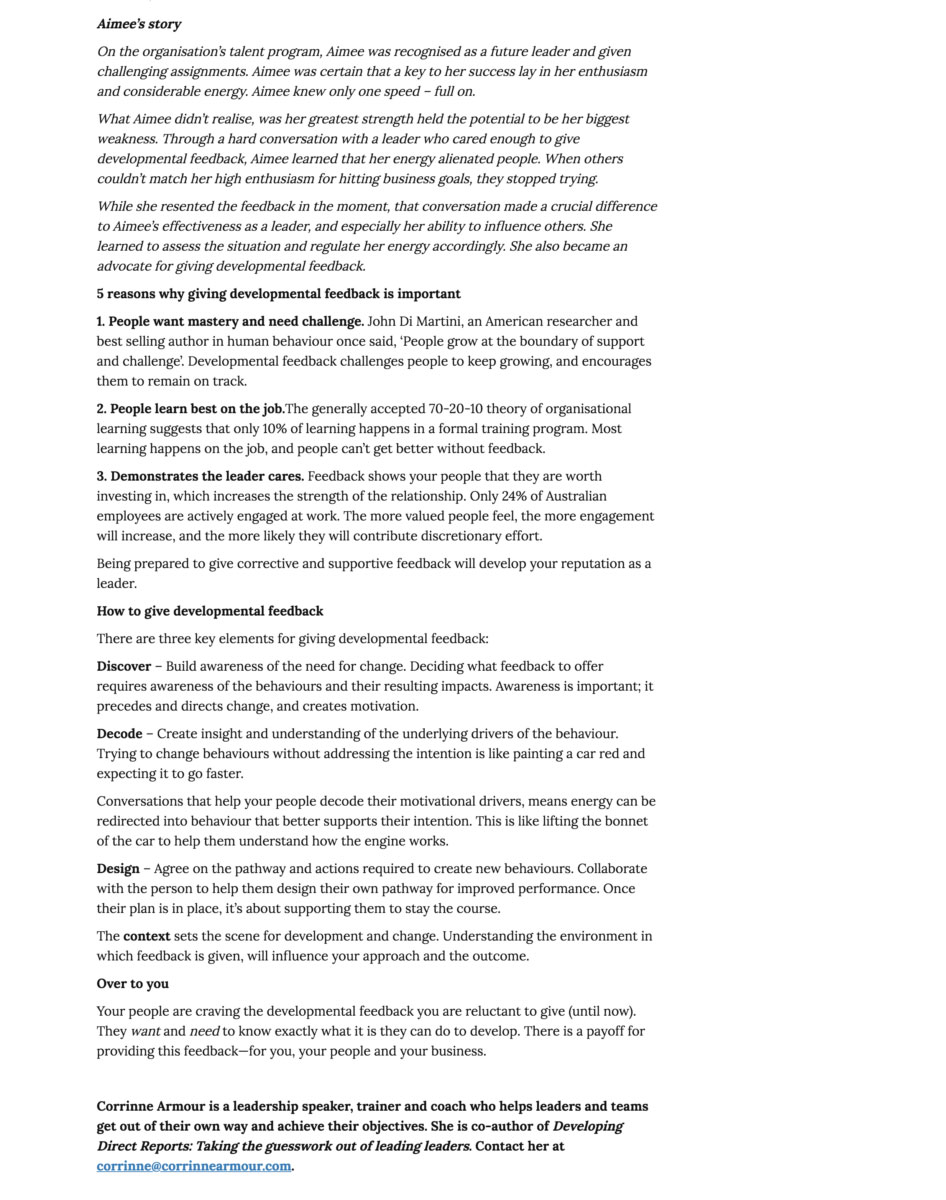First published in MyBusiness.com.au on 09 October 2015
Just as a plane needs constant adjustment and realignment to remain on its flight path, your people need regular feedback to remain on their path to development.
People want the full story. Ironically, they want constructive feedback more than you are prepared to give it. In 2014, Zenger and Folkman surveyed 899 individuals globally about their relationship to feedback. They found people wanted corrective feedback, more than praise, if it was provided in a constructive manner. 72% said their performance would improve if their manager provided corrective feedback.
Why don’t you give feedback?
Don’t have time. There is always more to do in a day than time in which to do it. It’s easy to put off a potentially uncomfortable interaction on the basis of being too busy.
Don’t know how it will be received. You worry you will offend or upset the person and perhaps damage the relationship.
Don’t see it as your role. As a junior in an organisation, success is about growing yourself. As a leader, success is about growing others.
Don’t have the skills. The ability to give feedback is one that must be cultivated in addition to job-specific technical skills.
Don’t realise the importance of it. Perhaps, until now, you hadn’t realised the value of constructive feedback. Perhaps it’s hard to believe that what is so clear to you (as an observer) can be unknown to others.
Aimee’s story
On the organisation’s talent program, Aimee was recognised as a future leader and given challenging assignments. Aimee was certain that a key to her success lay in her enthusiasm and considerable energy. Aimee knew only one speed – full on.
What Aimee didn’t realise, was her greatest strength held the potential to be her biggest weakness. Through a hard conversation with a leader who cared enough to give developmental feedback, Aimee learned that her energy alienated people. When others couldn’t match her high enthusiasm for hitting business goals, they stopped trying.
While she resented the feedback in the moment, that conversation made a crucial difference to Aimee’s effectiveness as a leader, and especially her ability to influence others. She learned to assess the situation and regulate her energy accordingly. She also became an advocate for giving developmental feedback.
5 reasons why giving developmental feedback is important
1. People want mastery and need challenge. John Di Martini, an American researcher and best selling author in human behaviour once said, ‘People grow at the boundary of support and challenge’. Developmental feedback challenges people to keep growing, and encourages them to remain on track.
2. People learn best on the job.The generally accepted 70-20-10 theory of organisational learning suggests that only 10% of learning happens in a formal training program. Most learning happens on the job, and people can’t get better without feedback.
3. Demonstrates the leader cares. Feedback shows your people that they are worth investing in, which increases the strength of the relationship. Only 24% of Australian employees are actively engaged at work. The more valued people feel, the more engagement will increase, and the more likely they will contribute discretionary effort.
Being prepared to give corrective and supportive feedback will develop your reputation as a leader.
How to give developmental feedback
There are three key elements for giving developmental feedback:
Discover – Build awareness of the need for change. Deciding what feedback to offer requires awareness of the behaviours and their resulting impacts. Awareness is important; it precedes and directs change, and creates motivation.
Decode – Create insight and understanding of the underlying drivers of the behaviour. Trying to change behaviours without addressing the intention is like painting a car red and expecting it to go faster.
Conversations that help your people decode their motivational drivers, means energy can be redirected into behaviour that better supports their intention. This is like lifting the bonnet of the car to help them understand how the engine works.
Design – Agree on the pathway and actions required to create new behaviours. Collaborate with the person to help them design their own pathway for improved performance. Once their plan is in place, it’s about supporting them to stay the course.
The context sets the scene for development and change. Understanding the environment in which feedback is given, will influence your approach and the outcome.
Over to you
Your people are craving the developmental feedback you are reluctant to give (until now). They want and need to know exactly what it is they can do to develop. There is a payoff for providing this feedback—for you, your people and your business.
STAY IN THE LOOP



